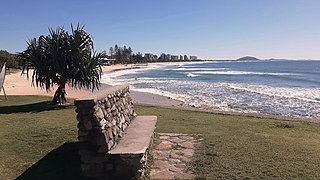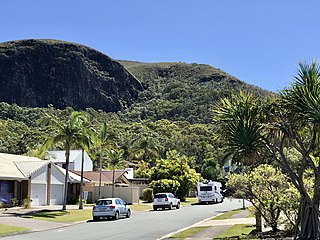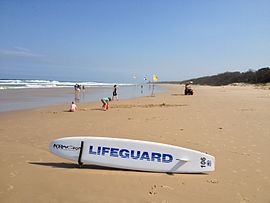
The Sunshine Coast is a peri-urban region in South East Queensland, Australia. It is the district defined in 1967 as "the area contained in the Shires of Landsborough, Maroochy and Noosa, but excluding Bribie Island". Located 100 km (62 mi) north of the centre of Brisbane in South East Queensland, on the Coral Sea coastline, its urban area spans approximately 60 km (37 mi) of coastline and hinterland from Pelican Waters to Tewantin.

Peregian Beach is a beach and small coastal town on the Sunshine Coast, Queensland, Australia. It is a suburb split between two local government areas with the eastern coastal in the Shire of Noosa and the western hinterland part in the Sunshine Coast Region. In the 2021 census, Peregian Beach had a population of 4,972 people.

Maroochydore is a coastal town in the Sunshine Coast Region, Queensland, Australia. In the 2021 census, the urban area of Maroochydore had a population of 63,673 people.

Mudjimba is a coastal suburb in the Sunshine Coast Region, Queensland, Australia, and forms part of the Maroochydore urban centre. In the 2021 census, Mudjimba had a population of 2,664 people.

Alexandra Headland is a coastal suburb of Maroochydore in the Sunshine Coast Region, Queensland, Australia. In the 2021 census, Alexandra Headland had a population of 4,235 people.

Bli Bli is a rural town and locality in the Sunshine Coast Region, Queensland, Australia. In the 2021 census, the locality of Bli Bli had a population of 10,138 people.

Coolum Beach is a beachside town and coastal suburb in the Sunshine Coast Region, Queensland, Australia. In the 2021 census, the suburb of Coolum Beach had a population of 9,152 people.
Doonan is a rural residential locality split between the Sunshine Coast Region and the Shire of Noosa, both in Queensland, Australia. In the 2021 census, Doonan had a population of 3,727 people.
Pacific Paradise is a suburb of Maroochydore in the Sunshine Coast Region, Queensland, Australia. In the 2021 census, Pacific Paradise had a population of 2,675 people.

Mount Coolum is a coastal suburb in the Sunshine Coast Region, Queensland, Australia. In the 2021 census, Mount Coolum had a population of 4,545 people.

Twin Waters is a coastal suburb of Maroochydore in the Sunshine Coast Region, Queensland, Australia. In the 2021 census, Twin Waters had a population of 2,966 people.
Kunda Park is an industrial suburb of Buderim in the Sunshine Coast Region, Queensland, Australia. In the 2021 census, Kunda Park had a population of 22 people.

Yaroomba is a coastal suburb in the Sunshine Coast Region, Queensland, Australia. In the 2021 census, Yaroomba had a population of 2,043 people.
Yandina Creek is a rural locality in the Sunshine Coast Region, Queensland, Australia. In the 2021 census, Yandina Creek had a population of 872 people.

Maroochy River is a rural hinterland locality in the Sunshine Coast Region, Queensland, Australia. In the 2021 census, Maroochy River had a population of 1,667 people.

The Sunshine Coast Region is a local government area located in the Sunshine Coast region of South East Queensland, Australia.

The Maroochy River is a river in South East Queensland, Australia. The river rises from the eastern slopes of the Blackall Range and flows east through Eumundi before entering the sea at Cotton Tree, Maroochydore. Other populated centres in the catchment include Nambour, Eudlo, Yandina and Coolum.

The Maroochy air crash was an aircraft accident that occurred at 11.10am on 30 December 1950 at Maroochydore beach, Queensland, Australia. Three children were killed and fourteen others were seriously injured as a result of the accident.
Cotton Tree is a coastal neighbourhood within the suburb of Maroochydore in the Sunshine Coast Region, Queensland, Australia.



















